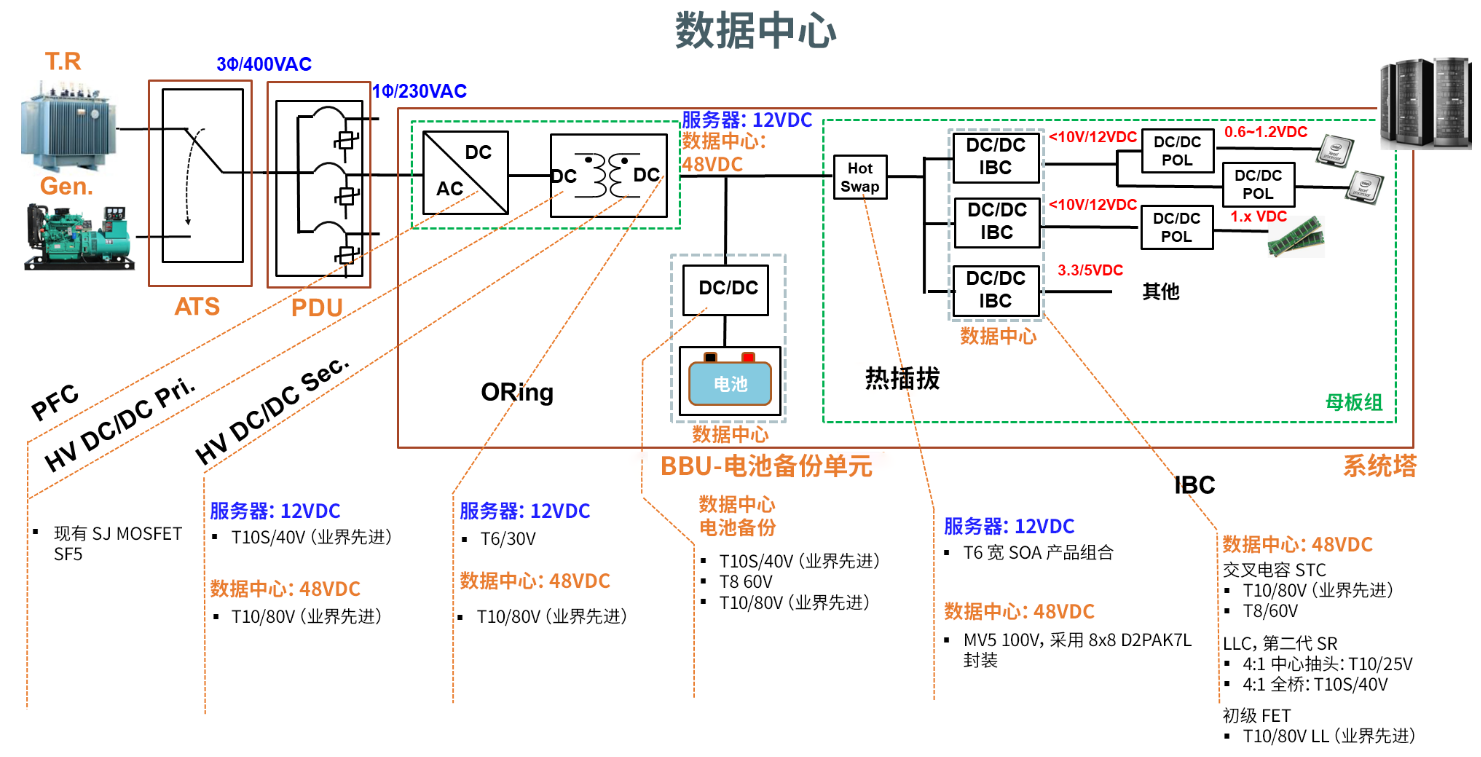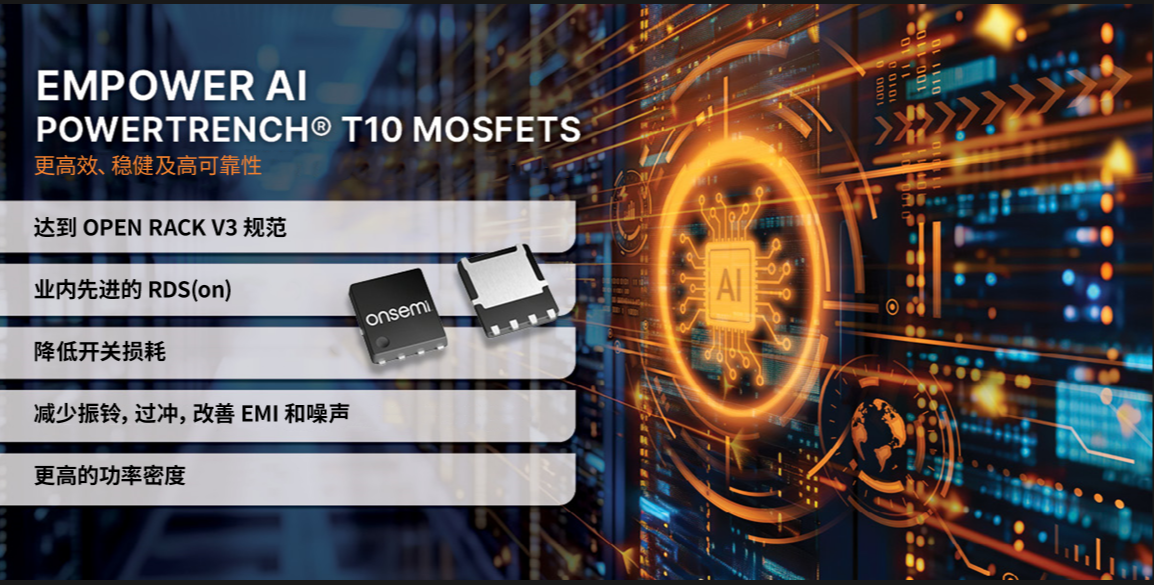Source: ON Mei Author: Senior Director, Aditya Jian
Driven by emerging applications such as cryptocurrencies and artificial intelligence/machine learning (AI/ML), energy consumption in data centers is huge and will grow rapidly to meet user demand. According to the latest report from the International Energy Agency (IEA), data centers will consume 460 TWh (terawatt-hours) of electricity in 2022, accounting for about 2% of total global electricity consumption. In the United States, home to one-third of the world's data centers, power consumption is 260 TWh, accounting for 6% of total power consumption.
Predicting the future is challenging, depending on how many very power-hungry graphics processing units (Gpus) are deployed to cope with the demands of AI technology, and of course on further increasing air conditioning to lower the temperature in the data center. The International Energy Agency reports that data center power consumption will grow to at least 650 TWh (40%) by 2026, but it could be as high as 1,050 TWh (128%).
Data centers support AI trends
Artificial intelligence is an extremely power-hungry technology, and the data centers that support its operation need to have sufficient computing power and power delivery capacity.
A recent study by Sweden's RISE Research Institute clearly demonstrates the dramatic changes brought about by the rapid adoption of the technology. ChatGPT, for example, reached 1 million users in just five days after its launch in November 2022. They reached 100 million users in two months, compared to nine months for TikTok and two and a half years for Instagram.
For reference, a search on Google takes just 0.28Wh, which is equivalent to turning on a 60W light bulb for 17 seconds.
In contrast, training GPT-4 requires 1.7 trillion parameters and 13 trillion tokens (word fragments), which is a completely different proposition. To do this, multiple servers containing 25,000 Nvidia A100 Gpus are required, each with a power consumption of about 6.5 kW. OpenAI says the training takes 100 days, consumes about 50 GWh and costs $100 million.
Clearly, AI is going to be a huge game-changer for the data center, requiring levels of computing power and energy consumption that far exceed anything we've seen to date.
Data center 48V architecture
Early data centers used a centralized power architecture (CPA), which centrally converted primary power (grid) voltage to 12V (bus voltage), then distributed it to various servers and converted it locally to a 5V or 3.3V logic level using relatively simple converters.
However, as power demands grew, the current (and associated losses) on the 12V bus became unacceptably high, forcing system engineers to switch to a 48V bus arrangement. According to Ohm's law, the current is reduced by four times, and the loss is reduced by four times the square. This configuration is known as distributed Power Architecture (DPA).
At the same time, the voltage of the processor and some other components is also constantly decreasing, eventually dropping to the subvolt level, resulting in the need for multiple secondary voltage rails. To solve this problem, a second-order conversion technique is used to convert the 48V voltage to the 12V bus via a DC-DC converter (called an intermediate bus converter - IBC), and then output additional voltages from the 12V bus as needed.

Demand for high energy efficiency MOSFETs
Power losses inside data centers pose challenges for operators. The first, and most obvious, is that they're paying for power that doesn't help servers run. Secondly, any wasted energy is converted into heat, which must be dealt with somehow. With hyperscale AI servers requiring up to 120 kW of power (and certainly increasing over time), even at 50 percent load, 2.5 percent loss at 97.5 percent peak efficiency would waste 1.5 kW of power per server, equivalent to a full-time electric heater.
Handling heat may require heat dissipation measures in the power conversion system, such as radiators or fans. These measures increase the size of the power supply, take up space that could be used for more computing power and, in the case of fans, consume electricity and increase costs. Because the temperature inside the data center needs to be tightly controlled, excessive losses can also raise the ambient temperature, which means more air conditioning is needed to cool it down. This is both a capital expenditure and an operating cost, while also taking up space.
Clearly, converting the main (grid) voltage into the voltage needed to drive AI Gpus and other devices as efficiently as possible is of great benefit to data center operators.
Therefore, a lot of work has been done on power topology over the years, introducing technologies such as Totem Pole PFC (TPPFC) in the front-end PFC stage to improve its efficiency. In addition, in order to improve efficiency, diode rectifiers have been replaced by MOSFETs, and technologies such as synchronous rectification have been introduced.
Optimizing the topology is only half of the equation, and to optimize efficiency, all components must also be as efficient as possible, especially MOSFETs that are critical to the conversion process.
When MOSFETs are used for switching power conversion, there are two main forms of loss: on-off loss and switching loss. The on-off loss is caused by the resistance (RDS(ON)) between the drain and the source and is always present when the current flows. Switching losses are caused by a combination of gate charge (Qg), output charge (QOSS), and reverse recovery charge (Qrr), which are replenished at each switching cycle. Since the current trend is to increase the switching frequency to reduce the size of the magnetic element, this loss also becomes quite significant as the replenishment frequency increases.
Obviously, the lower the on-off loss and switching loss of a particular MOSFET, the higher the overall conversion efficiency of the power system.
Introduction to PowerTrench T10 MOSFET
Synchronous rectification is now a key technology in all high performance, high current, low voltage power conversion applications, especially in data center server applications. In this application, several MOSFET parameters, including RDS(ON), Qg, QOSS, and Qrr, directly affect the conversion efficiency, and device manufacturers are trying to find ways to reduce these effects.
ON's PowerTrench T10 MOSFET uses a new shielded gate channel design to achieve ultra-low Qg values with an RDS(ON) of less than 1mOhm. The latest PowerTrench T10 technology not only reduces ringing, overshoot and noise, its industry-leading soft recovery diode also reduces Qrr. This achieves a good compromise balance between on-resistance performance and recovery characteristics, while also enabling low loss fast switching with good reverse recovery characteristics.
Overall, the improvements in the parameters of the PowerTrench T10 device increase the efficiency of the medium and low voltage, high current switching power supply solution. In general, the switching loss can be reduced by up to 50% compared to the previous generation of devices, while the on-off loss can be reduced by 30% to 40%.
On launched the PowerTrench T10 technology in the 40V series and 80V series. NTMFWS1D5N08X (80V, 1.43mΩ, 5mm x 6mm SO8-FL package) and NTTFSSCH1D3N04XL (40V, 1.3mΩ, 3.3mm x 3.3mm) Dual cooling under source package) provides best-in-class efficiency (FOM) for power units (Psus) and intermediate bus converters (IBCs) in AI data center applications. They achieved 97.5% PSU efficiency and 98% IBC efficiency as required by the Open Rack V3 specification.

Conclusion
The AI revolution has arrived, and no one is quite sure what it will mean for the future power delivery needs of data centers. What is certain, however, is that a new set of challenges has emerged. Scarce real estate resources and power grid constraints make it difficult to find new locations with sufficient capacity. Overall power demand in critical IT areas has surged, placing a heavy burden on power costs. To meet these demands, data center owners must not only build new facilities, but also push existing facilities to the limit, aiming to achieve high-density configurations in the megawatt per square foot level. With power levels sure to exceed 100 kW, power conversion will be a key focus to achieve efficient operation, ensure heat dissipation, reliably increase power density, and save space in cramped modern data centers. ON's PowerTrench T10 technology delivers industry-leading RDS(ON), higher power density, reduced switching losses, and better thermal performance, reducing total system costs. Innovative power semiconductor technologies such as the PowerTrench T10 will be a key component of the future.
免责声明: 本文章转自其它平台,并不代表本站观点及立场。若有侵权或异议,请联系我们删除。谢谢! Disclaimer: This article is reproduced from other platforms and does not represent the views or positions of this website. If there is any infringement or objection, please contact us to delete it. thank you! |


